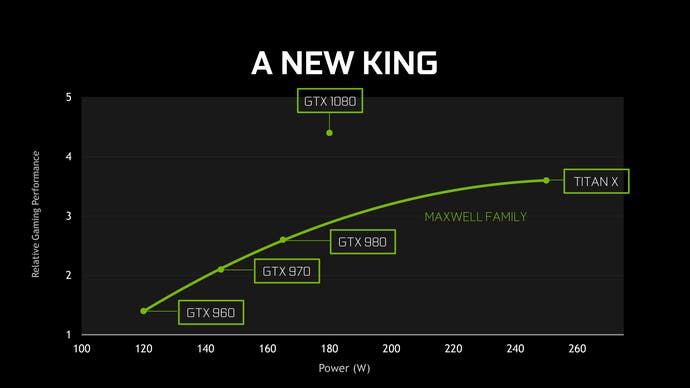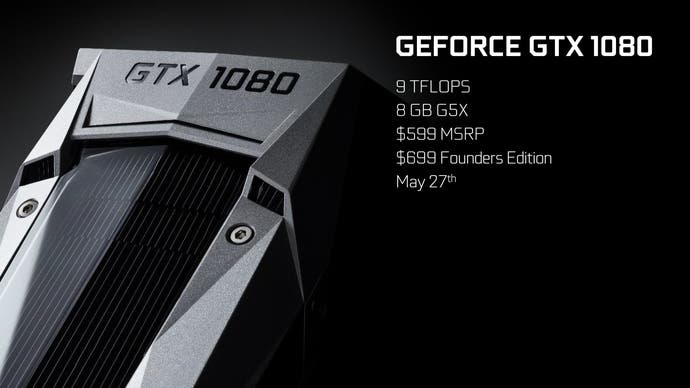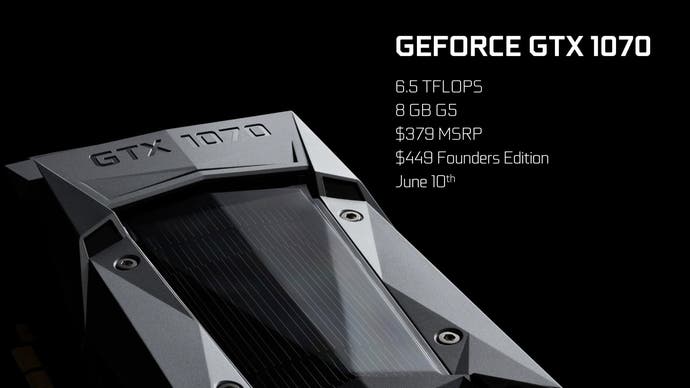Nvidia unveils GTX 1080 and GTX 1070: a new level in GPU power
"Irresponsible levels of performance."
Nvidia has officially revealed the GeForce GTX 1080 and GTX 1070, based on its new Pascal architecture, offering an astonishing leap in performance and power efficiency over its existing 900-series Maxwell cards. According to Nvidia, the GTX 1080 is faster than two GTX 980s in SLI, shipping to users on May 27th at $599. Meanwhile, the GTX 1070 offers Titan X level performance for just over one third of the price - $379 - and is set to launch on June 10th.
Both products are based on Nvidia's GP104 processor, featuring a 7.2 billion transistor count. The GTX 1080 features 2560 CUDA cores, offering 9 TFLOPs of performance, and is paired with 8GB of Micron's state-of-the-art GDDR5X (or G5X, as Nvidia called it). Meanwhile, no core count has been announced for the GTX 1070, but we do know that it ships with 8GB of standard GDDR5 and has a 6.5 TFLOP performance level.
Clock-speeds and overclocking headroom look remarkable. Boost clock on GTX 1080 is rated at higher than 1700MHz, but a real-time Unreal Engine 4 demo shown on stage saw the card overclocked on air, rock-solid at 2114MHz. On-screen stats using the EVGA Precision X monitoring software saw temperature at just 67 degrees Celsius, with the G5X memory operating at 5508MHz - 10gbps effective.
In terms of direct comparisons with the firm's previous performance leader, Nvidia revealed a power efficiency/performance graph which seems to suggest something along the lines of a 20 per cent performance increase for GTX 1080 running at 180W, compared to Titan X operating at 250W.

Of course, Add-in-board manufacturers will be supplying their own products around the suggested retail prices, but Nvidia will be selling its own 'Founder's Edition' variants through select partners, bumping up prices to $699 for the GTX 1080 and $449 for the GTX 1070. Nvidia boss Jen-Hsung Huang promises "crazy overclockability" for these parts perhaps suggesting some kind of custom power delivery mechanism. We'll look into this and report back, but all Pascal cards will be overclockable - this isn't just limited to the more expensive variants.
In our recent 'In Theory' piece, we pieced together a potential scenario for the performance level of the new wave of Pascal GPUs, based on available information derived from the official spec for the much larger GP100 chip, combined with the more plausible leaks from the Far Eastern press. We suggested that Pascal could offer Titan X-level performance for GTX 970 money - based on an established precedent that saw the 970 beat its big-chip predecessor (GTX 780 Ti) once an overclock was in place. Some might say that Nvidia has exceeded our expectations here, assuming that Titan X level performance is indeed delivered at stock clocks. However, GTX 1070 gets a $40 price-bump compared to its $330 predecessor. Regardless, the price-to-performance ratio is simply remarkable.
Bearing in mind we were already quite optimistic about Pascal's chances based on the GP100 specs, the bottom line here is that on the day, Nvidia exceeded expectations last night by some distance. Jen-Hsun Huang stated several times that Pascal took over two years to complete with the input of "thousands" of engineers and a multi-billion dollar investment. The inference here is that the firm intends to maintain its massive market dominance by outspending AMD in terms of research and development.

The firm also revealed new technology at the heart of the Pascal architecture, called 'simultaneous multi-projection', with the GPU able to create 16 independent viewports simultaneously in one pass with stereo support - and no performance penalty. Two scenarios for this tech were showcased, the first being full perspective correction on satellite displays on a tri-screen set-up, positioned in a 'curved' surround arrangement.
The second was for virtual reality. Right now, VR is rendered by creating a full resolution output, warping the output to match the lenses on the HMD - and in the process, losing a lot of visible resolution. With simultaneous multi-projection, each eye view is a composite of four projections, meaning that 'wasted' resolution is massively reduced, and the end result is anything from a 40 to 80 per cent increase in performance (the on-screen demo seemed to be in the 45-50 per cent area, rising from 65fps to 96fps with the single-pass technology enabled). [UPDATE 7/5/16 3:48pm: Having discussed this in more depth with Nvidia this morning, the performance increase comes from two components - the reduction in resolution as stated, and also the hardware acceleration provided for the stereo viewpoint, which essentially halves the processing overhead for geometry.]
Other new technologies revealed at the event were software-based in nature, with the reveal of a VRWorks audio set-up based on path-traced sound using a physically modelled audio simulation. This is paired with physically-based haptic feedback for VR controllers, in combination with PhysX. Nvidia seemed to suggest that all of this new VR technology will be open sourced, and revealed that a series of tech demos - dubbed Nvidia VR Funhouse - will be made available in a single Steam download.

Nvidia also revealed Ancel - an in-game 3D camera system, allowing you to pause gameplay, adjust special effects, brightness, field of view and then create your own 2D, 3D and surround screenshots using anything up to 1000x resolution. The Division, The Witness, Lawbreakers, The Witcher 3: Wild Hunt, Paragon, No Man's Sky and Unreal Tournament are all set to receive Ancel support. Although it seems to operate at the driver level, clearly developer support is essential here in getting Ancel properly integrated.
There was no mention of DirectX 12 at the event - something of a sticking point for Nvidia cards thus far - but accompanying press materials describe "new asynchronous compute advances" that "improve efficiency and gaming performance", so it'll be interesting to see how Pascal performs there in an area where the existing Maxwell cards have had some issues.
Overall, it's difficult not to be impressed with the show Nvidia put on here. We knew that GTX 1080 would be the new flagship, but to post a circa 20 per cent improvement to Titan X performance is immense, factoring in the 28 per cent reduction in TDP. For its part, assuming that the Titan X comparison holds true, the GTX 1070 offers a potential 40-55 per cent improvement in performance over the GTX 970, costing just $40 more. It could be as radical a proposition as GTX 970 was back at launch - a product we described at the time as "the GPU that nukes almost the entire high-end graphics market from orbit."
Going into the event, Nvidia staff gave us the impression that Pascal would offer the same level of ambition and performance that defined the GPU classics of the past - graphics cards like the GTX 970 and the 8800GT. Of course, the jury's out until both products are in the Digital Foundry lair with the benchmarks complete, but in the meantime, hopes are sky-high based on this remarkable showing.
Nvidia's Pascal gaming cards were unveiled at an event hosted in Austin, Texas that we attended. Nvidia paid for travel and accommodation.

